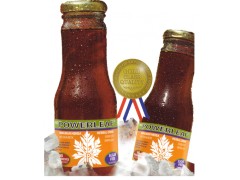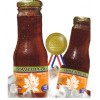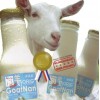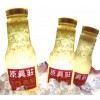專家研究半年‧木瓜葉可治蚊症
本地醫藥人員與外國醫藥專家,耗時6個月時間針對木瓜葉研究後,已經證實木瓜葉具有治療骨痛熱症的療效!
掌管檳州衛生委員會主席彭文寶週三向《光明日報》證實,理科大學、大馬亞洲醫藥、科學及科技大學、奧地利維也納大學的醫藥專家,聯手合作針對木瓜葉進行6個月研究之後,已經證實木瓜葉對於治療骨痛熱症具有療效作用。
他說,木瓜葉的確對於骨痛症具有療效作用,尤其被黑斑蚊叮上,患上骨痛症者,食用木瓜葉可以提高與生產人體血小板對抗骨痛症病毒。
小血板恢復正常
他指出,骨痛症可以破壞人體的小血板,尤其人體體溫會不斷上升,一旦小血板降至5萬每微升指數可能就會致命。
他說,有關報告指一般正常人體的小血板是維持在15萬至25萬每微升,一旦感染骨痛熱症人體的小血板每微升指數就會下降。
他表示,這些醫學專家研究時,曾以小老鼠進行研究後得悉的療效結果。同時參與這項研究包括大馬亞洲醫藥、科學及科技大學與理科大學卡特里申博士、曼梳醫生、蘇拉斯博士及維也納大學的醫藥專家瓦爾特博士。
他透露,其實這項研究報告還未出爐前,他本身就曾食用過木瓜葉汁,尤其是他發燒時也會飲用。
“過去,身邊朋友患上骨痛熱症時,我都會鼓勵他們食用木瓜葉汁,結果隔一兩天后就擺脫了骨痛熱症,體內的小血板每微升指數也恢復正常。”
外勞用木瓜葉治蚊症
彭文寶指出,早前他巡視州內建築工地時發現,儘管有關建築工地被列為骨痛熱症病發黑區,不過工地上工作的外勞卻沒有人感染骨痛熱症。
“但是經過我與建築工地外勞進行交流之外後,才發現這些外勞,尤其是非法外勞,患上骨痛熱症之後,由於不敢前往政府醫院就醫,因此就以古方的木瓜葉來治療發燒或骨痛熱症疾病,結果真的取得了療效。”
有驅熱療效
他說,之後他也躍躍欲試了多次後,每當發燒時他就會喝下木瓜葉汁,的確有了一定的療效,況且木瓜葉汁屬於寒涼,當體內溫度上升時,喝下木瓜葉就有驅熱的療效。
他表示,由於木瓜葉具有療效作用,他曾要求檳州衛生局針對有關木瓜葉偏方進行研究,結果經過多名醫學專家證實後,木瓜葉是具有治療骨痛熱症的療效。
他說,目前還不清楚政府醫院會否使用木瓜葉來治療骨痛熱症,總之一切還有待衛生部進一步定奪。
木瓜葉治療骨痛熱症偏方
‧取下兩片木瓜葉
‧把木瓜葉清洗乾淨
‧再把木瓜葉放入水果較汁機較拌
‧再倒出榨取木瓜葉汁
‧倒入杯內,添加少許的鹽即可喝下
Alternative treatments for dengue fever
The best treatment for this infectious disease with no medical cure might lie in nature.
DENGUE fever is a problem that just does not seem to want to go away in Malaysia. And even worse, it seems to be escalating.
The latest report from the Health Ministry states that as of March 22, both the number of cases and deaths nationwide for the year have increased by 314% compared to the same period last year.
The problem is not just limited to Malaysia, although we are considered an endemic dengue hotspot.The number of dengue cases in the latest report totalled 23,633, while the number of deaths was 58.
The World Health Organisation (WHO) estimates there may be 50-100 million dengue infections globally every year, with two-fifths of the world population, or 2.5 billion people, at risk of this mosquito-borne infectious disease.
While being infected with dengue is an unpleasant experience – it is also known as breakbone fever – with typical symptoms being fever, headache, rashes, and muscle and joint pains, a healthy person’s immune system usually has no problems fighting the virus off.
The problem comes when dengue haemorrhagic fever develops.
This extreme form of the illness causes severe bleeding due to “leaky” blood vessels and delay in blood-clotting caused by low levels of platelets, which are essential in forming blood clots.
According to the WHO, an average of about 2.5% of those who develop dengue haemorrhagic fever die.
This number can exceed 20% in cases with no proper treatment, while the risk of death in those who receive the proper supportive treatment is less than 1%.
There is no cure for dengue, nor is there any vaccine for it, although there are several research teams currently working on one.
The main method of controlling this disease is via prevention; for example, ensuring that there is no stagnant water or any container where water can pool in around, fogging, using mosquito nets and repellent, and covering up or staying indoors at dawn and dusk when the Aedes mosquitoes are most active.
Medical management of dengue is purely supportive, with maintenance of the body’s fluid balance being the key objective, whether via oral rehydration therapy, intravenous fluid replacement, or in the worst-case scenario, blood transfusion.
With no definitive treatment from modern medicine available, it is not surprising that many have turned to alternative therapies for relief.
Papaya leaf juice
This is probably the most well-known alternative treatment for dengue.
Several small scientific studies have been carried out in dengue-endemic countries like India and Malaysia, looking into the efficacy of this herbal remedy.
While the results cannot be said to be definitive, due to their small study size, they are certainly promising.
The main effect of this juice lies in raising the level of platelets in dengue patients – a critical aspect of this viral infection.
One study, conducted by the Institute for Medical Research and Hospital Tengku Ampuan Rahimah, Klang, Selangor, reported that patients given papaya leaf juice showed a significant rise in their platelet levels 40 hours after first receiving the juice, compared to patients in the control group who were only on standard supportive therapy.
The open-label randomised controlled trial, published in Evidence-Based Complementary and Alternative Medicine last year, had a total of 228 participants recruited from the hospital’s dengue ward, divided almost equally between the control group and the juice group.
The patients in the juice group took the pure fresh juice extracted from 50gm of clean papaya leaves of the sekaki variety once daily for three consecutive days.
Pharmacist and holistic medicine practitioner Datuk Dr Rajen M adds that a blend of raw young papaya and papaya leaves made into a juice, taken two to three times a day, is one of the alternative therapies for dengue in Ayurvedic medicine.
He notes that consuming papaya in general is safe, and taking it does not contradict medical advice.
Tawa-tawa
This hairy herb is commonly used in the Philippines as an alternative treatment for dengue fever.
Also known as gatas-gatas or by its scientific name Euphorbia hirta, it is said to increase the platelet levels in dengue patients.
A 2012 animal study conducted by pharmacy students from the University of Santo Tomas, Manila, showed that a decoction of tawa-tawa did indeed increase platelet levels and decrease bleeding time in rats with induced thrombocytopenia (i.e. an abnormally low platelet level).
The Philippine’s Department of Science and Technology is currently researching the effect of this plant on dengue fever, and have stated their concern over possible toxicity resulting from overdosing on tawa-tawa.
Meanwhile, Philippine Star columnist Dr Willie T Ong said in a 2009 article that Filipino doctors in general allow dengue patients to take tawa-tawa as long as they clear it with them first.
He also explained how to prepare the herb: “Take five whole tawa-tawa plants. Cut off the roots, then wash and clean.
“Boil tawa-tawa in a pot of clean water. Pour the liquid and then let cool. Sip one glass three to four times a day.”
Traditional Chinese medicine
Inti International University Center for Traditional Chinese Medicine director and head of the traditional Chinese medicine (TCM) programme Dr Yong Kian Fui says that there is no cure for dengue fever in TCM either, and treatment is usually supportive based on the stage of the disease.
The acupuncturist and Chinese physician notes that because of the vague symptoms of dengue fever, most people are only diagnosed with the disease about four days after their fever starts.
TCM therapy at that stage consists of a herbal concoction based on the formulation called qin wen bai tu san.
“This helps to clear the plaque and detox the body,” he says.
Patients have to take one dose daily for three days. If their platelet levels are still low by the end of that period, Dr Yong says they would be referred to the hospital for further management.
He adds that he personally also prescribes a bitter gourd and meat soup, which should be double-boiled for two hours.
While the meat can be from any animal, including fish, it is crucial that the seeds in the bitter gourd must be included in the soup.
“According to TCM theory, bitter gourd is used to clear ‘fire’ and to detox the body.
“The meat neutralises the bitter gourd, so that it doesn’t become too ‘cooling’.”
Ayuverdic medicine
Dr Rajen explains that there are four ways to treat dengue patients according to Ayuverdic medicine.
Two methods are targeted at boosting the patient’s blood production and providing an antiviral effect: the papaya fruit and leaf juice mix mentioned earlier, and juice made from pegaga leaves, also known as India pennywort or Centella asiatica.
According to Dr Rajen, one dose of the pegaga juice is the amount obtained from juicing one handful of leaves.
The other two treatments are mainly applied for their general antiviral properties.
One is cow or goat colostrum, which can be drunk as often as desired. Colostrum is the first secretion from the animal’s mammary glands before the milk comes out.
The other is turmeric, which can be added to the patient’s food or milk.







